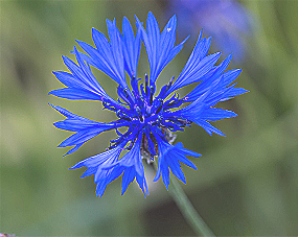Centaurea Cyanus Flower is the extract of blue cornflower flowers (Centaurea Cyanus L., an annual plant belonging to the Asteraceae family and native to Europe) obtained by extraction with soluble ethanol and water.

The name defines the structure of the molecule:
- Centaurea Cyanus refers to the scientific name of the cornflower plant, also known as Centaurea cyanus. It is a flowering plant of the Asteraceae family and is native to Europe. Cornflower extract or flower water comes from the petals or other parts of the plant Centaurea cyanus.
- Flower indicates that the part of the plant in question is the flower. It brings some of the aromatic and therapeutic properties of the plant from which it derives.
The synthesis process takes place in several stages:
- Harvesting. Flowers are hand-picked or mechanically harvested when they come to full bloom, typically in summer.
- Drying. The harvested flowers may be dried in the shade in a well-ventilated area to preserve their colors and active compounds.
- Extraction. The dried flowers are then immersed in a solvent (like alcohol or water) to extract beneficial compounds.
- Filtering. The extract is filtered to remove any impurities or flower residues.
- Concentration. The extracted liquid can be concentrated under vacuum or other methods to get a more potent extract.
What it is used for and where
Medical
Centaurea Cyanus Flower is an extract obtained from the flower heads of the Centaurea cyanus, the common cornflower, which has a long history of herbal use and is used in biomedicine for the treatment of minor eye inflammations due to some interesting components such as uronic monocarboxylic acids (especially galacturonic acid) flavonoids, tannins and anthocyanins with anti-inflammatory activity . In traditional medical science, cornflower infusion was used as a mouthwash for gingivitis, ulcers, to improve digestion and against infections. Aqueous extract of cornflower was used for cleansing and care of the eyes, against conjunctivitis. The seeds as a laxative for children.
The phytochemical composition is listed in this table (1):

Cosmetics
Optimised extract of Blue Cornflower (Centaurea Cyanus) with anti-inflammatory, astringent and skin-cleansing properties.
Skin conditioning agent. It is the mainstay of topical skin treatment as it has the function of restoring, increasing or improving skin tolerance to external factors, including melanocyte tolerance. The most important function of the conditioning agent is to prevent skin dehydration, but the subject is rather complex and involves emollients and humectants that can be added in the formulation.

Typical commercial product characteristics Dried Blue Cornflower
| Appearance | Dried Cornflower petals |
Loss on Drying
| ≤7% |
Heavy Metals
| <10ppm |
Total Plate
| <10,000cfu/g |
| Storage | Keep away from strong,direct light. Clean,cool,dry area |
| Shelf life | 18 months |
CAS 84012-18-0
EC number 281-664-0
More on this:
Centaurea Cyanus studies
References_____________________________________________________________________
(1) Chiru, T. A. T. I. A. N. A. (2009). Phytochemical study of Centaurea cyanus L. USAMV Bucharest, Series A, 52, 293-297.
![]() Centaurea cyanus flower
Centaurea cyanus flower 



